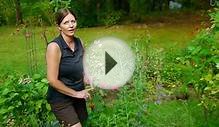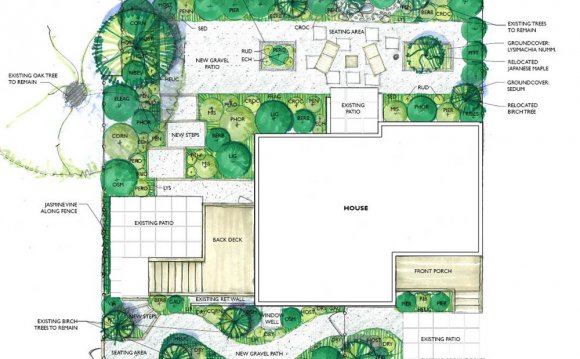
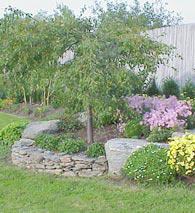 Consider making curved, raised beds in your landscape out of natural materials, such as stone, to create additional visual interest.
Consider making curved, raised beds in your landscape out of natural materials, such as stone, to create additional visual interest.
Fences offer places for plants to grow and a way to distinguish one area of the garden from another.
Don't forget simple natural elements, such as rocks in the garden. They help break up a planting bed and can double as stepping stones.
Don't be afraid to grow your edible flowers, shrubs and trees in the front yard where everyone can appreciate them.
Simple water gardens provide habitat for frogs, dragonflies and exotic plants. To keep mosquitoes away, place mosquito dunks in the pond or raise fish.
While an edible landscape is a special type of landscape due to the emphasis on fruits, vegetables, and herbs, the process of creating a landscape plan is the same as with purely ornamental features. There are more new homeowners in the country than ever before.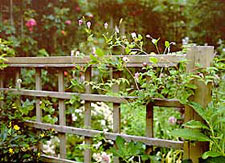 Many, when faced with landscaping a new yard, feel overwhelmed. You can do the design and installation yourself or work with a professional landscape designer. Either way, it helps to do some creative thinking beforehand, even if you intend on hiring a designer eventually. The more specific you can be with your likes and dislikes, and the more concrete you can be in describing your landscape dreams and desires, the more likely you'll be happy with the results.
Many, when faced with landscaping a new yard, feel overwhelmed. You can do the design and installation yourself or work with a professional landscape designer. Either way, it helps to do some creative thinking beforehand, even if you intend on hiring a designer eventually. The more specific you can be with your likes and dislikes, and the more concrete you can be in describing your landscape dreams and desires, the more likely you'll be happy with the results.
Since we're talking about edible trees, shrubs, and flowers, you might want to find a few different people to help you, such as one who is a specialist in edible crops and another who is a more traditional designer who can put the plan all together. But first let's start with exploring your dreams.
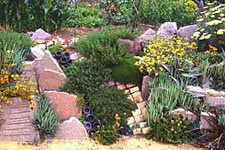 Your Landscaping Scrapbook
Your Landscaping Scrapbook
In an effort to be as specific as possible, the first step into your new landscape is a purely imaginary one - a scrapbook filled with images that appeal to you. These could be images not just of plants and gardens but of structures, walkways, walls, fences, ornaments, and other landscape features. Here are the supplies you'll need to assemble: a binder, approximately 200 sheets of binder paper, scissors, several sharp pencils with good erasers, tape, ruler, and a few sheets of standard graph paper.
With these materials plus an armful of home and garden magazines, your job is to create your own personal garden design scrapbook. The scrapbook will be invaluable on trips to the nursery, hardware store, or lumberyard, and it will help you avoid disappointments when you deal with contractors, carpenters, bricklayers, concrete masons, and landscapers.
If you take the time to create a binder filled with the specifics of what you like in a garden, you'll go a long way toward answering questions decisively. Instead of waving your hands in the air and hoping for the best, your landscaping binder will allow you to point to the exact thing you want: "I want this type of walkway with this type of crushed stone."
 Each time you see something appealing in a photograph or illustration, cut the picture out of the magazine and tape it to a piece of binder paper. Be sure to make notations on the paper as to what it is, specifically, that you like. Three months later, in an entirely different frame of mind, you may find yourself wondering what it was in the photograph that caught your eye.
Each time you see something appealing in a photograph or illustration, cut the picture out of the magazine and tape it to a piece of binder paper. Be sure to make notations on the paper as to what it is, specifically, that you like. Three months later, in an entirely different frame of mind, you may find yourself wondering what it was in the photograph that caught your eye.
Three-Dimensional Thinking
Once you've collected your ideas, it's time to make use of that graph paper, but heed this warning: While virtually every book ever written on the subject of home landscaping stresses the importance of committing a plan to paper, the precise nature of the process presents some hazards to creativity. Yes, it is important for you to know the dimensions of the lot, which direction the prevailing winds blow, what the exposure of the yard is (morning or afternoon sun or shade), the location of water spigots, electrical outlets, etc. But there's something about putting these facts down on paper that makes it possible to design the life and spirit right out of the project.
If you think you may be subject to the tyranny of graph paper, neutralize its effect by starting the composition of the plan outdoors. To do this, take your landscaping scrapbook to the yard, along with a few dozen 12-inch wooden stakes, a half dozen 6-foot, 2- by 2-inch wooden stakes (available at any lumberyard), a spool of heavy cotton string or twine (500 feet should do), a couple of long garden hoses, two handfuls of clothespins, and a few old bed sheets. An odd list of equipment, to be sure, but useful.
YOU MIGHT ALSO LIKE
